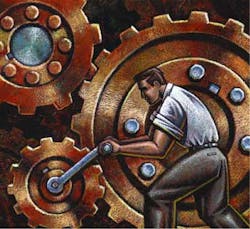Automation Supports Knowledge Work
Every major evolutionary advance in the human experience was made possible by a similar advancement in automation. We stand at a point in manufacturing where we face fundamental changes in how we manufacture, the nature of work itself, and the role of the worker in the next generation of manufacturing. Automation has helped us become the most productive generation in history, but we have reached a performance plateau, and current automation is not adequate to propel us into the next generation of manufacturing.
The stage is set for change: the information technology is available and proven; automation systems have embraced Internet communications as a core technology; and there is a realization that human assets in our plants are underutilized and knowledge work is an integral part of next generation manufacturing. The work process changes required in knowledge work empower workers with authority and responsibility. Collaborative Automation Systems (CAS), however, must facilitate understanding and engagement.
Moving to knowledge work requires workers to be extricated from the basic operation of the plant and fill a more explicit role. This should be accomplished by enabling automation to drive repetitive functions, steady state and transitioning, and any other precise execution. In this way, consistent best practices are embedded and humans only intervene on an exception basis.
Improve through focus
Today’s businesses desire to improve performance by focusing all company assets on common objectives. This requires manufacturing to operate collaboratively with the entire company. Because timely and actionable information is critical for this collaboration, it is clear that the elimination of any information or work process barriers that interfere with effectively supporting a much broader scope of collaboration needs to be a primary objective of CAS evolution.
There is no room for rigid business processes, tunnel vision or ambiguous information. The breadth of scope needs to be manufacturing-wide with unified and adaptable business processes that can access any valid information in context, at any time, in real time, without ambiguity, over the entire manufacturing cycle. The depth of this context is at least as important as its breadth. The context needs to include production time, data associated with a dynamic view of manufacturing assets, methods and work process state, data quality and application relevance.
While companies have traditionally managed operations to meet performance goals, the static nature of the goals, along with the time lapse involved in obtaining performance measures, severely hindered optimal outcomes. Next generation manufacturing requires more than hindsight analysis to manage performance in real time.
Companies need to better understand, control and improve their manufacturing capabilities. The majority of manufacturers cannot answer many fundamental questions about their operations, such as capable to promise and profitable to promise, which require a production-cycle perspective to derive performance measures.
Performance management includes elements of both production control and product cost accounting. The purpose of traditional performance management is to achieve and sustain optimum economic “added value” throughout the production cycle by precisely deploying manufacturing assets to execute planned demand effectively. Traditional performance management does not adapt dynamically, so manufacturers need a real-time solution. Real-time performance management is a collaborative concept that utilizes a dynamic context to add a new level of performance intelligence. Its primary value comes from eliminating “opportunity cost” by exposing previously unrevealed capacity to unplanned production opportunities. Effective fulfillment of unplanned demand results in significant performance improvements.
Next generation manufacturing will succeed or fail based on how the next generation work force is utilized. Even more than sharing information, next generation manufacturing requires a redistribution of authority and responsibility.
Dave Woll, [email protected], is a vice president and Dick Slansky, [email protected], is a senior analyst at ARC Advisory Group Inc., in Dedham, Mass.

